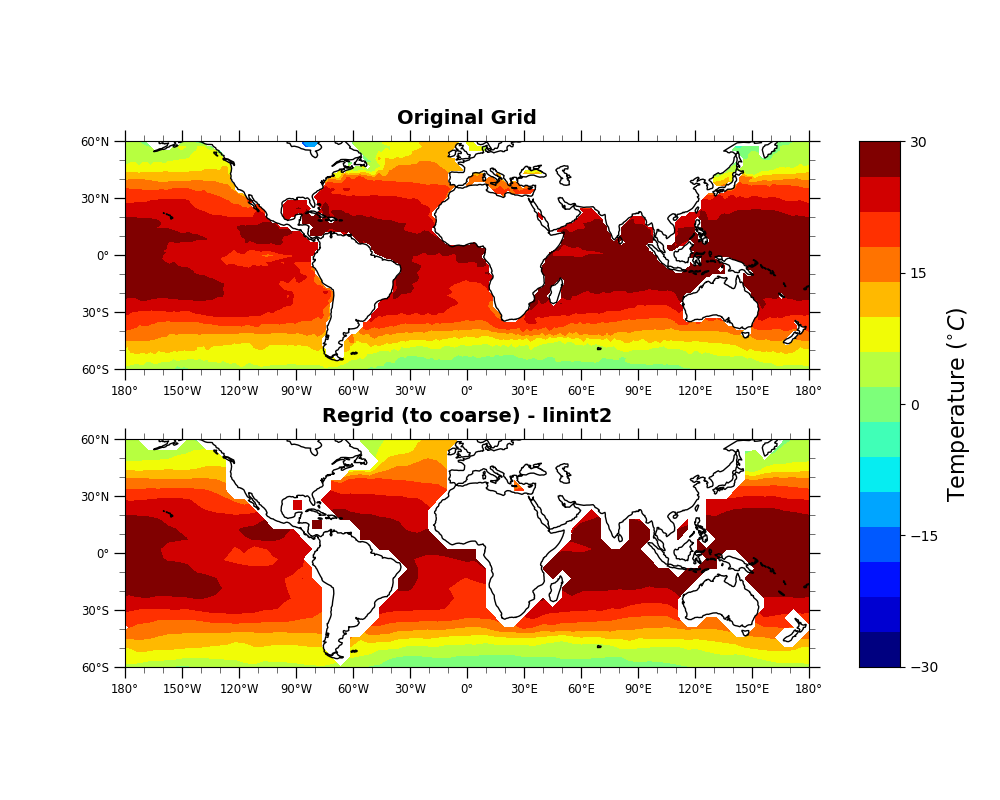Note
Click here to download the full example code
linint2_example.py¶
- This script illustrates the following concepts:
Usage of geocat-comp’s linint2 function
Bilinear Interpolation from a rectilinear grid to another rectilinear grid
Usage of geocat-datafiles for accessing NetCDF files
Usage of geocat-viz plotting convenience functions
- See following GitHub repositories to see further information about the function and to access data:
For linint2 function: https://github.com/NCAR/geocat-comp
For “sst.nc” file: https://github.com/NCAR/geocat-datafiles/tree/main/netcdf_files
- Dependencies:
geocat.comp
geocat.datafiles (Not necessary but for conveniently accessing the NetCDF data file)
geocat.viz (Not necessary but for plotting convenience)
numpy
xarray
cartopy
matplotlib
mpl_toolkits
Import packages:
import cartopy.crs as ccrs
import matplotlib.pyplot as plt
import numpy as np
import xarray as xr
from cartopy.mpl.geoaxes import GeoAxes
from matplotlib import cm
from mpl_toolkits.axes_grid1 import AxesGrid
import geocat.datafiles as gdf
import geocat.viz.util as gvutil
from geocat.comp import linint2
Read in data:
# Open a netCDF data file using xarray default engine and load the data
# into xarray.DataArrays
ds = xr.open_dataset(gdf.get('netcdf_files/sst.nc'))
sst = ds.TEMP[0, 0, :, :].chunk()
lat = ds.LAT[:]
lon = ds.LON[:]
GeoCAT-comp function call:
# Provide (output) interpolation grid
newlat = np.linspace(min(lat), max(lat), 24)
newlon = np.linspace(min(lon), max(lon), 72)
# Invoke `linint2` from `geocat.comp`
newsst = linint2(sst, newlon, newlat, icycx=False)
Plot:
# Generate figure and set its size (width, height) in inches
fig = plt.figure(figsize=(10, 8))
# Generate Axes grid using a Cartopy projection
projection = ccrs.PlateCarree()
axes_class = (GeoAxes, dict(map_projection=projection))
axgr = AxesGrid(fig,
111,
axes_class=axes_class,
nrows_ncols=(2, 1),
axes_pad=0.7,
cbar_location='right',
cbar_mode='single',
cbar_pad=0.5,
cbar_size='3%',
label_mode='') # note the empty label_mode
# Create a dictionary for common plotting options for both subplots
plot_options = dict(transform=projection,
cmap=cm.jet,
vmin=-30,
vmax=30,
levels=16,
extend='neither',
add_colorbar=False,
add_labels=False)
# Plot original grid and linint2 interpolations as two subplots
# within the figure
for i, ax in enumerate(axgr):
# Plot contours for both the subplots
if (i == 0):
sst.plot.contourf(ax=ax, **plot_options)
ax.set_title('Original Grid', fontsize=14, fontweight='bold', y=1.04)
else:
p = newsst.plot.contourf(ax=ax, **plot_options)
ax.set_title('Regrid (to coarse) - linint2',
fontsize=14,
fontweight='bold',
y=1.04)
# Add coastlines to the subplots
ax.coastlines()
# Use geocat.viz.util convenience function to add minor and major tick
# lines
gvutil.add_major_minor_ticks(ax)
# Use geocat.viz.util convenience function to set axes limits & tick
# values without calling several matplotlib functions
gvutil.set_axes_limits_and_ticks(ax,
xticks=np.linspace(-180, 180, 13),
yticks=np.linspace(-60, 60, 5))
# Use geocat.viz.util convenience function to make plots look like NCL
# plots by using latitude, longitude tick labels
gvutil.add_lat_lon_ticklabels(ax, zero_direction_label=False)
# Add color bar and label details (title, size, etc.)
cax = axgr.cbar_axes[0]
cax.colorbar(p)
axis = cax.axis[cax.orientation]
axis.label.set_text(r'Temperature ($^{\circ} C$)')
axis.label.set_size(16)
axis.major_ticklabels.set_size(10)
plt.show()

Total running time of the script: ( 0 minutes 1.071 seconds)